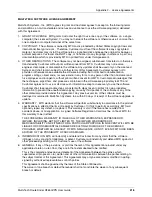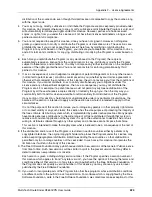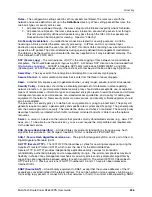
Glossary
Multi-Tech RouteFinder RF650VPN User Guide
230
integrity and encryption of datagrammes. You can define ESP (and other protocols) for the RouteFinder
from VPN|IPSEC Configurations.
ExpirationDate
– Certificates and keys may have a limited lifetime, and expiration dates are used to
monitor and control their useful life.
Filter
– A set of rules that define what packets may pass through a network. Filters can use source,
destination, or protocol to determine whether to pass or discard a packet transmission. Part of a packet
(the header) must contain information that matches the information in the defined rules, or else the packet
filter will discard it.
Filtering
– The act or process of defining which data traffic is to be allowed between the network and
hosts, typically using packet filter rules. Filtering is the central part of firewall security.
With packet filter rules, you define which data traffic is allowed between the networks and hosts. You can
also define particular packets to be filtered and are not to be allowed to pass through the firewall. Several
types of filtering exist (e.g., Protocol filtering, port number filtering, URL address filtering, and IP address
filtering). See also "Rules".
Finger
– Windows NT and Windows 2000 have a TCP/IP utility called Finger. This utility is an old TCP/IP
tool (very popular on UNIX systems) that matches an e-mail address with the person who owns it and
provides information about that person. While the Finger utility is fairly old (there are more advanced tools
available that perform the same general function) it still works and can be a useful tool in certain
situations.
The Finger utility was actually developed as the Finger Information Protocol. Finger was designed to
provide an interface to the Remote User Information Program (RUIP). RUIP provides information about
users who have accounts on UNIX-based computer networks. The Finger utility was created six years
before the Internet was born. The first documentation on the Finger utility was in IETF RFC742, dated
December 1977. A popular slogan promoting the phone book's yellow pages was "Let your fingers do the
walking". The utility was christened "Finger", since the utility was basically designed for tracking down
people.
The Finger Information Protocol let UNIX users on college campuses create a profile, called a "Plan
page", which included personal and job-related information. A Plan page was similar to a personal home
page on the Internet today. So when someone "Fingered" your e-mail address, they learned more about
you.
The Finger utility is a command line tool, so in Windows NT or Windows 2000 you must first access a
command-prompt window to use it. You then type the command followed by an e-mail address.
Firewall
– A device that serves to shield and thus protect a (partial) network (e.g., RouteFinder) from
another network (e.g. the Internet). The entire network traffic runs via the firewall where it can be
controlled and regulated. Technically this can be achieved in different ways. The use of special hardware
firewalls is rare. More frequent is the use of routers with firewall options. The most common is use of
firewall software on a specially-dedicated computer.
Gateway
– A combination of hardware and software that links two different types of networks. E.g.,
gateways between e-mail systems allow users on different e-mail systems to exchange messages.
Hacker
– A person who tries to, and/or succeeds at defeating computer security measures.
Hacking Lexicon
– The terms used by hackers; entire dictionaries exist to document hacking terms (e.g.,
http://www.robertgraham.com/pubs/hacking-dict.html
). These documents clarifies many of the terms
used within the context of information security (infosec).
Hash
– A one-way security function that takes an input message of arbitrary length and produces a fixed-
length digest. Used in SHA (Secure Hash Algorithm).
Header
– The portion of a packet, preceding the actual data, containing source and destination
information. It may also error checking and other fields. A header is also the part of an electronic mail
message which precedes the body of a message and contains, among other things, the message
originator, date and time







































